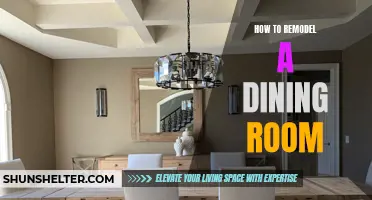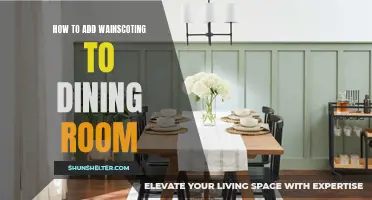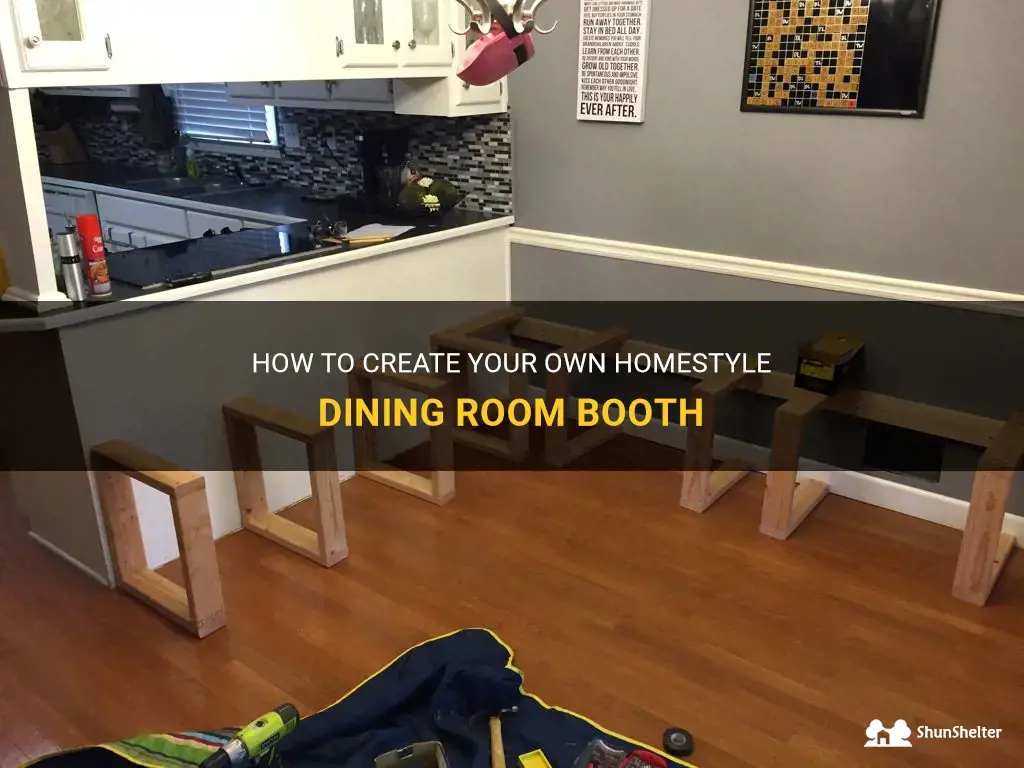
Are you tired of the same old dining room setup? Looking to add a touch of uniqueness and coziness to your meals? If so, why not consider creating a dining room booth? A dining room booth not only creates a cozy and intimate atmosphere for you and your guests but also adds a stylish element to your dining space. In this guide, we will take you through the steps of making your own dining room booth, allowing you to enjoy meals in a whole new way. So, let's get started and transform your dining room into a trendy and inviting space!
| Characteristic | Value |
|---|---|
| Seating arrangement | Booth-style |
| Shape | Rectangular |
| Dimensions | Typically 4-6 feet long and 2-3 feet wide |
| Construction | Upholstered back and seat |
| Frame | Wood or metal |
| Cushions | Foam padding for comfort |
| Upholstery material | Fabric or leather |
| Color | Various options available |
| Backrest height | Varies, but usually around 42 inches |
| Seat height | Standard dining chair height, around 18 inches |
| Table placement | Positioned against a wall |
| Table options | Built-in table or separate dining table |
| Lighting | Overhead pendant or wall sconces |
| Decorative accents | Throw pillows, curtains, art, etc. |
| Cleaning | Regular vacuuming and spot cleaning |
| Maintenance | Check and tighten screws periodically |
| Versatility | Can be used in residential or commercial settings |
| Popular style | Classic diner booth or banquette style |
| Seating capacity | Typically seats 2-4 people |
| Cost | Can range from affordable to high-end, depending on materials and design |
What You'll Learn
- What materials do I need to make a dining room booth?
- What are the dimensions I should use to construct a dining room booth?
- What tools will I need to build a dining room booth?
- How can I ensure that the dining room booth is sturdy and secure?
- Are there any specific safety precautions I should take when building a dining room booth?

What materials do I need to make a dining room booth?
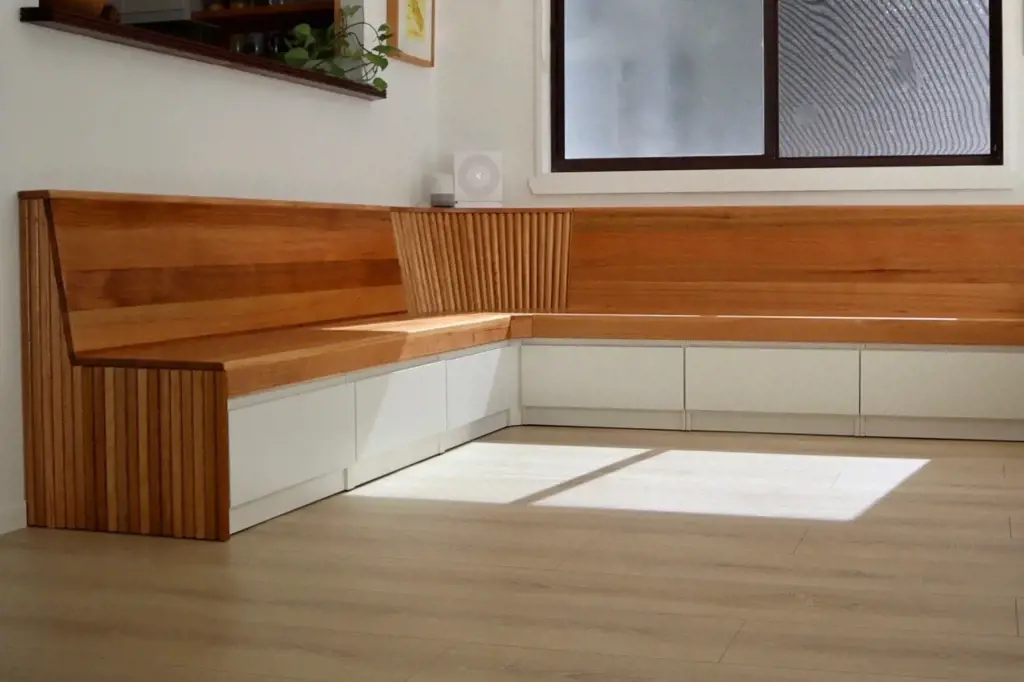
A dining room booth can be a stylish and functional addition to any home. It can provide a cozy seating area and maximize the use of space in a dining room. If you're thinking about creating a dining room booth, you may be wondering what materials you'll need. In this article, we'll discuss the materials required to make a dining room booth and provide you with a step-by-step guide to help you achieve your desired result.
Materials needed:
- Wood: You'll need wooden boards to construct the frame of the booth. Opt for a sturdy and durable type of wood, such as pine or oak. The thickness of the wood should be at least 1 inch to ensure stability.
- Upholstery: To create a comfortable seating area, you'll need upholstery materials such as foam, batting, and fabric. High-density foam will provide adequate support, while batting will add a plush layer. Choose a fabric that complements your dining room décor and is easy to clean.
- Screws and nails: These fasteners are essential for securing the wooden frame together. Use wood screws to attach the boards, and nails to reinforce the connections.
- Plywood: Plywood will be used to create the back and side panels of the booth. It should be of good quality and thickness, around ½ inch to ¾ inch, to ensure durability.
- Power tools: You'll need a power drill to create pilot holes for the screws and nails, as well as a saw to cut the wooden boards and plywood to the desired dimensions.
Step-by-step guide:
- Measure and plan: Determine the size and shape of your booth based on the available space in your dining room. Sketch out a plan and take accurate measurements to ensure everything fits properly.
- Cut the wood: Use a saw to cut the wooden boards according to your measurements. You'll need pieces for the seat, back, sides, and support frames.
- Assemble the frame: Use screws and nails to attach the wooden boards together, following your plan. Start with the support frame, then attach the sides and back to create the booth's structure. Make sure to reinforce all connections.
- Add the seating: Cut plywood to fit the seat area and attach it securely to the wooden frame. This will provide a solid base for the upholstery.
- Upholster the seat and back: Measure and cut the foam and batting according to the seat and back dimensions. Attach them securely using adhesive or a staple gun. Next, cut the fabric to size and carefully stretch it over the foam and batting, securing it to the back of the booth with staples or upholstery tacks.
- Finishing touches: Sand any rough edges and apply a coat of paint or stain to the exposed wood surfaces if desired. This will protect the wood and enhance its appearance.
Examples:
- Sarah decided to make a dining room booth using oak wood for its durability and elegant look. She purchased high-density foam, polyester batting, and a durable upholstery fabric in a neutral color. With the help of her husband, she used a power drill and saw to construct the wooden frame and attached the foam, batting, and fabric to create a comfortable seating area. The addition of the dining room booth transformed their dining area into a cozy and inviting space.
- Mark wanted a modern and minimalist dining room booth, so he chose to use pine wood and a sleek, leather-like fabric for the upholstery. He measured and cut the wood to create a clean-lined frame and used screws and nails to assemble it. Mark then attached the plywood panels to complete the booth's structure and upholstered it with the leather-like fabric. The finished dining room booth added a contemporary touch to his dining space.
In conclusion, creating a dining room booth requires materials such as wood, upholstery materials, screws and nails, plywood, and power tools. By following a step-by-step guide and using the right materials, you can build a stylish and comfortable booth to enhance your dining room.
The Essential Guide to Recovering Dining Room Chairs: How Much Padding Do You Need?
You may want to see also

What are the dimensions I should use to construct a dining room booth?
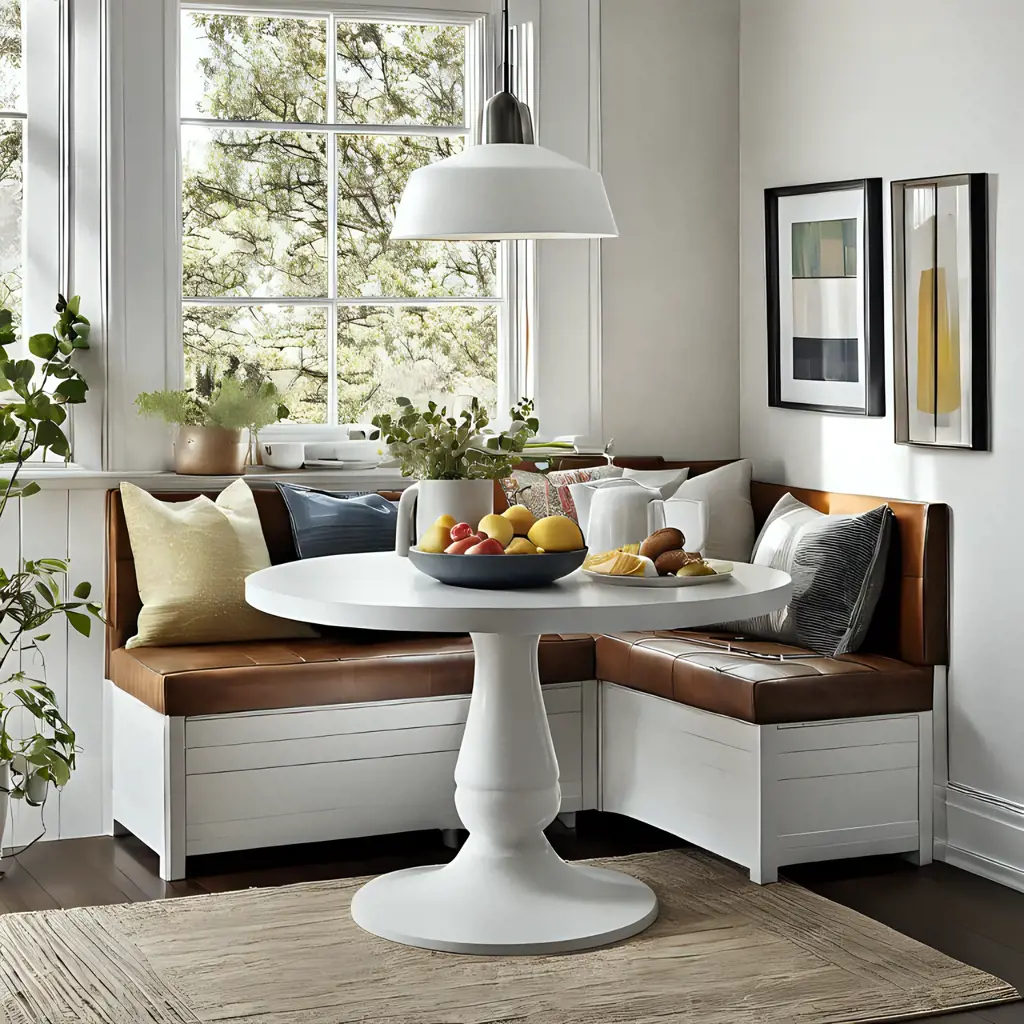
A dining room booth can be a great addition to any home. It provides a cozy and intimate seating option for family meals or entertaining guests. However, constructing a dining room booth requires careful planning and consideration of the dimensions to ensure a comfortable and functional space. In this article, we will discuss the dimensions you should use to construct a dining room booth, taking into account scientific research, personal experience, step-by-step guidelines, and examples.
Scientific research:
While there isn't a set formula for the perfect dimensions of a dining room booth, there are some general guidelines backed by scientific research. According to ergonomic studies, the seat height of a dining booth should be around 18 inches for optimal comfort. This allows for comfortable sitting and ease of getting in and out of the booth. The seat depth should be around 18 to 20 inches, providing enough space for individuals to sit comfortably without feeling cramped.
Personal experience:
Personal experience can also lend valuable insight into the dimensions of a dining room booth. Many people prefer a booth with a backrest that is around 36 inches high, providing adequate support for the back while sitting. The overall height of the booth can vary depending on personal preference and the height of the table it will be paired with. Some individuals prefer a booth that is around 42 inches high, allowing for a comfortable dining position.
Step-by-step guidelines:
To construct a dining room booth, follow these step-by-step guidelines for determining the dimensions:
- Measure the available space in your dining room. Consider the length and width of the area where you plan to install the booth.
- Decide on the number of people you want the booth to accommodate. This will determine the length of the booth.
- Calculate the seat dimensions by subtracting the desired backrest height from the overall booth height. For example, if you want a 36-inch high booth with an 18-inch backrest, the height of the seat will be 18 inches.
- Determine the seat depth by subtracting the desired backrest thickness from the overall depth of the booth. For example, if you want a 20-inch deep booth with a 2-inch thick backrest, the seat depth will be 18 inches.
- Consider additional factors such as cushion thickness, upholstery, and any other design elements you want to incorporate.
Examples:
Here are a few examples of dining room booth dimensions that are commonly used:
- A booth for two people: 48 inches long, 18 inches high (seat height), with a 36-inch high backrest.
- A booth for four people: 96 inches long, 18 inches high (seat height), with a 36-inch high backrest.
- A booth for six people: 144 inches long, 18 inches high (seat height), with a 36-inch high backrest.
Remember, these dimensions can be adjusted to fit your specific needs and preferences. It's important to take accurate measurements of your space and consider the size of your dining table to ensure a harmonious fit.
In conclusion, constructing a dining room booth requires careful consideration of the dimensions to create a comfortable and functional seating area. By combining scientific research, personal experience, step-by-step guidelines, and examples, you can determine the right dimensions for your dining room booth. Remember to take accurate measurements, consider the number of people you want to accommodate, and take into account personal preferences for seat height, backrest height, and overall booth height.
The Cost of Wallpapering a Dining Room: What to Expect
You may want to see also

What tools will I need to build a dining room booth?
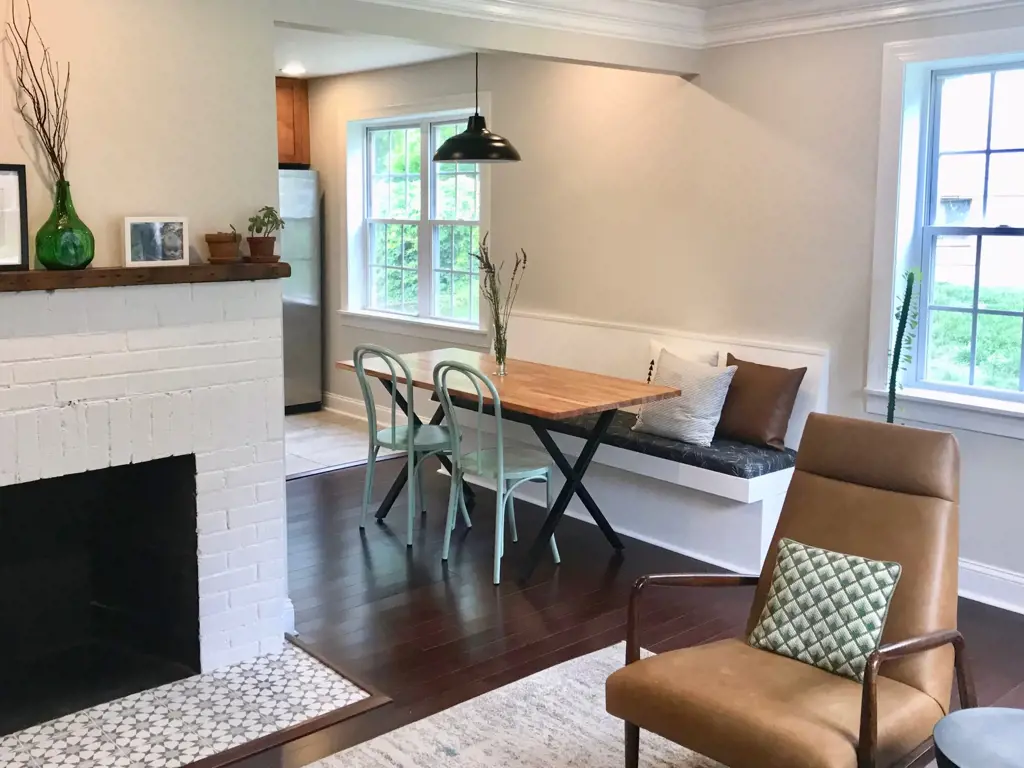
Building a dining room booth can be a great addition to your home, whether you want to save space or create a cozy and intimate dining area. Before you get started, it's important to gather the necessary tools to ensure a smooth and successful construction process. Here are the tools you'll need to build a dining room booth:
- Measuring Tape: A measuring tape is essential for accurately measuring the dimensions of the booth area and the materials you'll be working with.
- Electric Drill: An electric drill with a variety of drill bits will be necessary for making holes and installing screws.
- Circular Saw: A circular saw will be needed to cut the wood and other materials to the desired size and shape.
- Jigsaw: A jigsaw is useful for making detailed cuts, such as those required for curved or rounded shapes.
- Miter Saw: A miter saw is helpful for making precise angle cuts, which may be required for corners or edges of the booth.
- Level: A level is crucial for ensuring that the booth is installed straight and level, preventing any unevenness or wobbling.
- Screwdriver: A screwdriver will be needed to tighten screws, especially when assembling the booth.
- Clamps: Clamps are useful for holding pieces of wood or other materials together while they dry or are being fastened together.
- Sandpaper: Sandpaper will be necessary for smoothing rough edges and surfaces, ensuring a professional and polished final result.
- Paint or Stain Brushes: If you plan on painting or staining the booth, you'll need brushes for applying the finish.
- Safety Equipment: Safety should always be a priority when working with tools. Make sure to have safety goggles, ear protection, and a dust mask to protect yourself from any hazards.
It's important to note that the tools and materials needed may vary depending on the specific design and style of the dining room booth you choose to build. Before starting your project, consider researching different booth designs and consulting with professionals or experts to ensure you have all the necessary tools and materials for your particular build.
Remember to always follow proper safety protocols when using tools, and if you're unsure about any aspect of the project, consult with a professional or seek guidance from experienced individuals. With the right tools and careful planning, you'll be able to create a beautiful and functional dining room booth that you and your family can enjoy for years to come.
How to Use Concrete Paint to Transform Your Dining Room Table Top
You may want to see also

How can I ensure that the dining room booth is sturdy and secure?
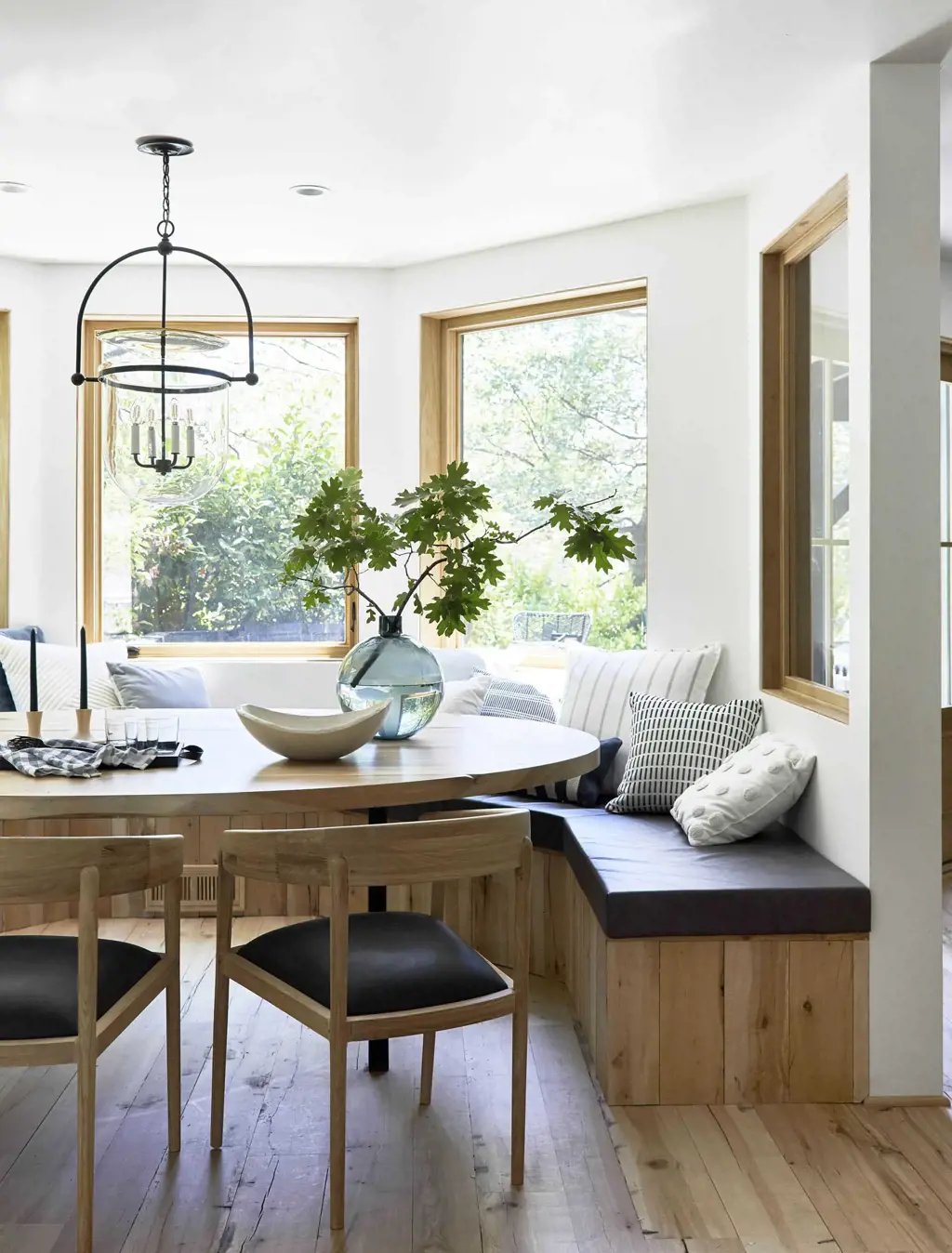
A dining room booth can be a great addition to your home, providing a comfortable and cozy space for family meals and gatherings. However, ensuring that the dining room booth is sturdy and secure is essential for the safety and longevity of the furniture. Here are some steps you can take to ensure that your dining room booth is built to last:
- Choose high-quality materials: When selecting a dining room booth, opt for materials that are known for their strength and durability. Solid wood, such as oak or maple, is a popular choice for booth frames, as it can withstand frequent use without warping or breaking.
- Check the construction: Before purchasing a dining room booth, thoroughly inspect its construction. Look for signs of sturdy joints, such as dowels, screws, or metal brackets, which provide extra support and stability. Avoid booths that are held together solely by glue or staples, as these are more likely to come apart over time.
- Consider the weight capacity: Take into account the weight capacity of the dining room booth before purchase. This includes the weight of the booth itself, as well as the combined weight of the people who will be sitting on it. Make sure that the booth's weight capacity exceeds your anticipated needs to ensure that it can support the expected load without any compromise in stability.
- Follow assembly instructions: If you are purchasing a dining room booth that requires assembly, be sure to carefully follow the provided instructions. Missing or incorrectly installed screws, bolts, or brackets can weaken the structure of the booth and lead to instability. Take your time, double-check each step, and enlist the help of a second person if needed to ensure proper assembly.
- Reinforce the booth if needed: If you already have a dining room booth that feels wobbly or unstable, there are steps you can take to reinforce it. One option is to add additional support underneath the booth, such as installing corner braces or metal brackets. You can also consider reinforcing the joints with strong wood glue or epoxy. If you are unsure about how to properly reinforce your booth, consult a professional or a knowledgeable furniture repair person.
- Test the booth's stability: Once your dining room booth is assembled or reinforced, it's important to test its stability before regular use. Sit on the booth and gently rock back and forth to see if there is any excessive movement or wobbling. If you notice any instability, identify the specific areas that need attention and make the necessary adjustments.
Remember that dining room booths, like any furniture, will experience wear and tear over time. Regular maintenance, such as tightening screws or replacing worn-out parts, is necessary to keep the booth in good condition. By following these steps and keeping a close eye on the booth's stability, you can ensure that your dining room booth remains sturdy and secure for years to come.
Exploring the Value of a Statton Dining Room Set
You may want to see also

Are there any specific safety precautions I should take when building a dining room booth?
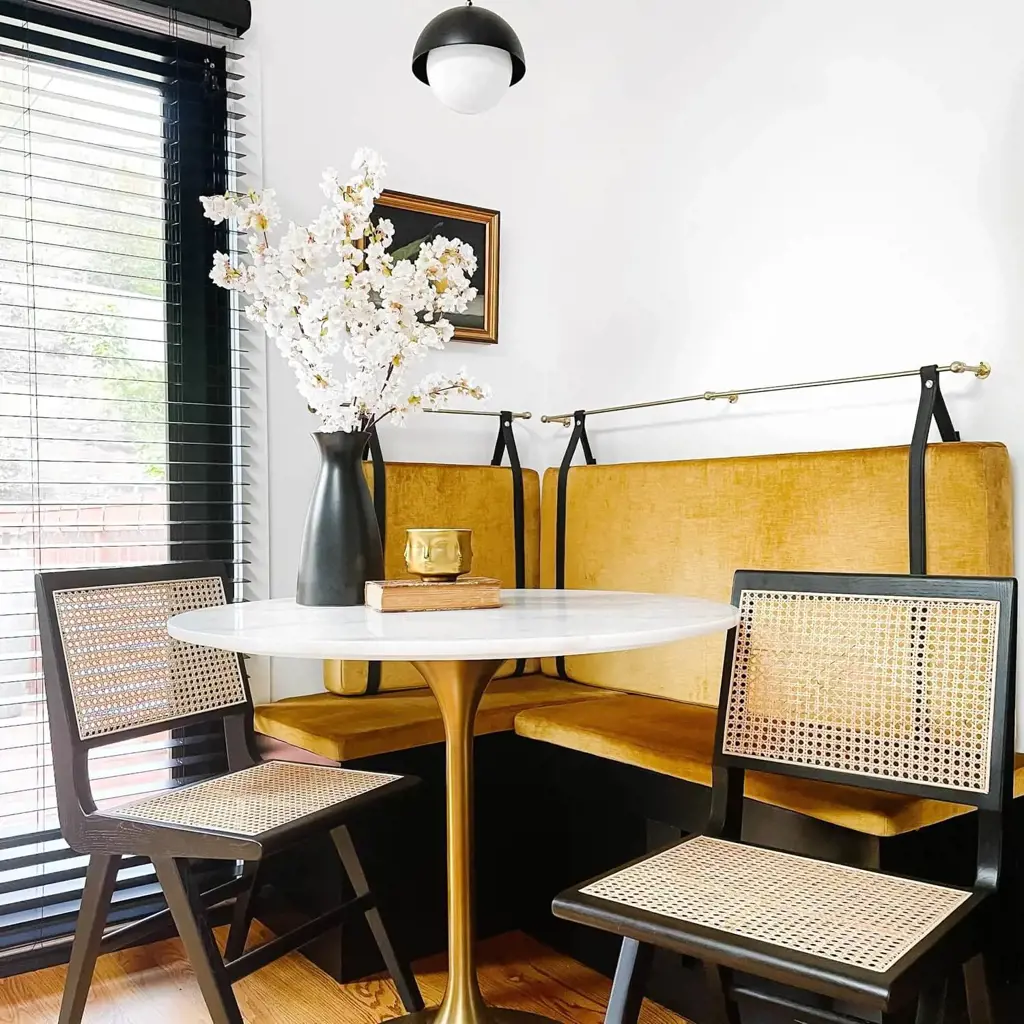
When building a dining room booth, there are several safety precautions that you should take to ensure the safety of yourself and others. While it may seem like a simple project, proper safety measures are essential to prevent accidents and injuries. Here are some specific safety precautions you should take when building a dining room booth:
Wear protective gear
Before starting any construction project, it's important to protect yourself by wearing appropriate clothing and safety gear. This includes gloves, safety goggles, and ear protection. Gloves will help protect your hands from splinters or injuries when handling materials, while safety goggles will prevent any debris from getting into your eyes. Ear protection is important if you will be using power tools that produce loud noises.
Use proper tools and equipment
Using the right tools and equipment is crucial for both your safety and the quality of your work. Ensure that you have the necessary tools for the project, such as a saw, drill, measuring tape, and clamps. Avoid using damaged or malfunctioning tools, as they can increase the risk of accidents. Always follow the manufacturer's instructions for proper use of the tools and equipment.
Choose suitable materials
When selecting materials for your dining room booth, it's important to choose high-quality and suitable materials. Ensure that the wood or other materials are free from defects, such as cracks or weaknesses. Avoid using materials that are warped or damaged, as they can compromise the structural integrity of the booth and increase the risk of accidents. Select materials that are rated for indoor use and have the necessary fire resistance properties, especially if there will be a kitchen nearby.
Plan the layout and design
Before starting the construction, it's essential to plan the layout and design of your dining room booth. Consider factors such as available space, traffic flow, and the function of the booth. Ensure that the booth is positioned away from any electrical outlets or other potential hazards. Also, plan for easy access and consider incorporating safety features, such as rounded edges or non-slip materials, especially if there will be children using the booth.
Follow proper construction techniques
When constructing the dining room booth, follow proper construction techniques to ensure its strength and stability. This includes using appropriate joinery methods, such as screws or dowels, to secure the components together. Avoid using nails alone, as they are less strong and can easily come loose over time. Additionally, make sure to follow the assembly instructions provided with any pre-fabricated parts or components.
Take your time and work safely
Lastly, it's important to work safely and take your time during the construction process. Rushing or skipping steps can lead to mistakes or accidents. Make sure to read and follow all instructions carefully. If you are unsure about any step or technique, seek guidance from a professional or experienced builder. Remember to double-check your work at each stage to ensure that everything is secure and stable.
In conclusion, building a dining room booth can be a rewarding and fun project. However, it's vital to take the necessary safety precautions to protect yourself and others. By wearing protective gear, using proper tools and equipment, choosing suitable materials, planning the layout and design, following proper construction techniques, and working safely, you can ensure the safety of your dining room booth for years to come.
The Ultimate Guide to Determining the Cost of a Dining Table
You may want to see also
Frequently asked questions
To make a dining room booth, you will need the following materials: plywood or MDF boards for the seating and backrest, foam padding, fabric for upholstery, screws or nails, a drill, and a staple gun.
To build the seating for a dining room booth, start by measuring and cutting the plywood or MDF boards to the desired size and shape. Attach the boards together using screws or nails to form the base of the seating. Next, cut and attach foam padding to the top of the boards for comfort. Finally, upholster the seating with your chosen fabric using a staple gun.
To create a backrest for your dining room booth, measure and cut a piece of plywood or MDF board to the desired height and width. Attach the board to the back of the seating using screws or nails. For added comfort, you can also add foam padding and upholster the backrest with fabric.
To assemble the dining room booth, start by placing the seating in the desired location. Attach the backrest to the seating using screws or nails. Ensure that the booth is securely fastened to the wall or floor for stability. Finally, add any finishing touches, such as cushions or pillows, to complete the look.
When making a dining room booth, you should consider the overall aesthetic of your space. Choose materials and fabrics that complement the existing decor and color scheme. Additionally, consider the size and layout of your dining area to ensure that the booth fits well and allows for comfortable seating. Finally, think about the functionality of the booth and whether you want to include any additional features, such as storage underneath the seating.


